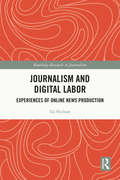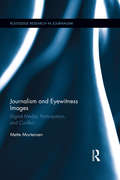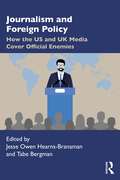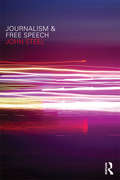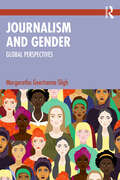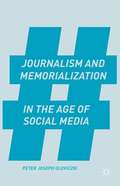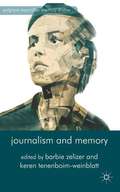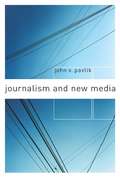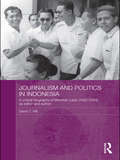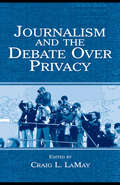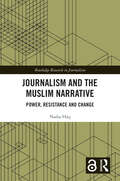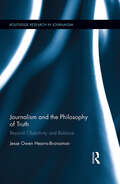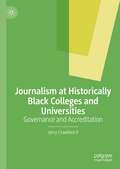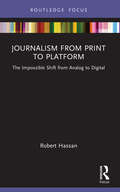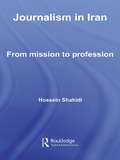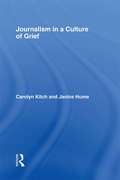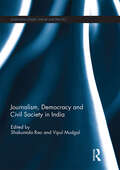- Table View
- List View
Journalism and Digital Labor: Experiences of Online News Production (Routledge Research in Journalism)
by Tai NeilsonThis book investigates journalists’ work practices, professional ideologies, and the power relations that impact their work, arguing that reporters’ lives and livelihoods are shaped by digital technologies and new modes of capital accumulation. Tai Neilson weaves together ethnographic approaches and critical theories of digital labor. Journalists’ experiences are at the heart of the book, which is based on interviews with news workers from Aotearoa New Zealand and the United States. The book also adopts a critical approach to the political economy of news across global and local contexts, digital start-ups, legacy media, nonprofits, and public service organizations. Each chapter features key debates illustrated by journalists’ personal narratives. This book will be of great interest to researchers and students of journalism, media and communication, cultural studies, and the sociology of work.
Journalism and Eyewitness Images: Digital Media, Participation, and Conflict (Routledge Research in Journalism)
by Mette MortensenBuilding on the vast research conducted on war and media since the 1970s, scholars are now studying the digital transformation of the production of news. Little scholarly attention has been paid, however, to non-professional, eyewitness visuals, even though this genre holds a still greater bearing on the way conflicts are fought, communicated, and covered by the news media. This volume examines the power of new technologies for creating and disseminating images in relation to conflicts. Mortensen presents a theoretical framework and uses case studies to investigate the impact of non-professional images with regard to essential issues in today’s media landscape: including new media technologies and democratic change, the political mobilization and censorship of images, the ethics of spectatorship, and the shifting role of the mainstream news media in the digital age.
Journalism and Foreign Policy: How the US and UK Media Cover Official Enemies
by Jesse Owen Hearns-BranamanThis edited collection brings together critical and up-to-date assessments of how mainstream American and British media cover their respective foreign policies, paying special attention to ‘official enemies’. In the age of the internet and social media, the reporting and commentary on world events by mainstream Western media remains tightly bound by the way in which Western governments promote their framing. This book explores the extent to which historical and recent Western media coverage has reflected and continues to reflect the foreign policies of the United States and the United Kingdom towards ten non-Western countries: Afghanistan, China, Cuba, Haiti, Iran, Palestine, Russia, Serbia, Syria, and Vietnam. Chapters analyse media coverage before, during and after war and geo-political and economic conflicts. Drawing from diverse perspectives and methods, including historical analysis, content analysis, critical discourse analysis, and critical linguistics, Journalism and Foreign Policy offers original insight into the Western media’s representation of important global events and developments, as well as the key scholarly issues of propaganda and digital media, across a wide range of recent coverage. This volume is key reading for academics and students in the areas of foreign policy and international politics, international communication, media content analysis, and journalism.
Journalism and Free Speech
by John SteelJournalism and Free Speech brings together for the first time an historical and theoretical exploration of journalism and its relationship with the idea of free speech. Though freedom of the press is widely regarded as an essential ingredient to democratic societies, the relationship between the idea of freedom of speech and the practice of press freedom is one that is generally taken for granted. Censorship, in general terms is an anathema. This book explores the philosophical and historical development of free speech and critically examines the ways in which it relates to freedom of the press in practice. The main contention of the book is that the actualisation of press freedom should be seen as encompassing modes of censorship which place pressure upon the principled connection between journalism and freedom of speech. Topics covered include: The Philosophy of Free Speech Journalism and Free Speech Press Freedom and the Democratic Imperative New Media and the Global Public Sphere Regulating Journalism Privacy and Defamation National Security and Insecurity Ownership News, Language Culture and Censorship This book introduces students to a wide range of issues centred around freedom of speech, press freedom and censorship, providing an accessible text for courses on journalism and mass media.
Journalism and Gender: Global Perspectives
by Margaretha Geertsema-SlighInformed by global and intersectional feminist perspectives, this textbook offers a broad introduction to the role of gender in journalism and considers how women in particular are represented in the news.This book begins by introducing theoretical approaches to journalism and diversity, feminisms and intersectionality, and media sociology. With reference to more than 90 countries and an emphasis on the Global South, it offers an expansive history of gender in journalism and insights from multiple global surveys. The next part of the text deals with women’s participation in news production, highlighting the challenges of men-dominated newsroom cultures. From there, the focus shifts to the way news media represent women in the news, including in relation to politics, war, and violence. The book concludes with a discussion of gender in international media development, gender and media activism, and gender in journalism education. Students are supported by chapter summaries, discussion questions, and a glossary of key terms to help reinforce knowledge and understanding.Inspiring students to incite positive change in the industry, Journalism and Gender is an essential text for those approaching this topic for the first time.This textbook features an e-book+ with interactive features such as links to websites, quizzes, and flash cards.
Journalism and Jim Crow: White Supremacy and the Black Struggle for a New America (History of Communication)
by Robert Greene W. Fitzhugh Brundage Kathy Roberts Forde Sid Bedingfield D'Weston Haywood Bryan Bowman Kristin L. Gustafson Blair Lm Kelley Razvan SibiiWhite publishers and editors used their newspapers to build, nurture, and protect white supremacy across the South in the decades after the Civil War. At the same time, a vibrant Black press fought to disrupt these efforts and force the United States to live up to its democratic ideals. Journalism and Jim Crow centers the press as a crucial political actor shaping the rise of the Jim Crow South. The contributors explore the leading role of the white press in constructing an anti-democratic society by promoting and supporting not only lynching and convict labor but also coordinated campaigns of violence and fraud that disenfranchised Black voters. They also examine the Black press’s parallel fight for a multiracial democracy of equality, justice, and opportunity for all—a losing battle with tragic consequences for the American experiment. Original and revelatory, Journalism and Jim Crow opens up new ways of thinking about the complicated relationship between journalism and power in American democracy. Contributors: Sid Bedingfield, Bryan Bowman, W. Fitzhugh Brundage, Kathy Roberts Forde, Robert Greene II, Kristin L. Gustafson, D'Weston Haywood, Blair LM Kelley, and Razvan Sibii
Journalism and Memorialization in the Age of Social Media
by Peter Joseph GloviczkiThis volume examines the rise of online memorial groups - virtual communities formed in the aftermath of tragic events - speaking to the notion that individual expression has become more visible and ubiquitous than ever before within a communication context. The book asserts the audience as decidedly active with users seeking a robust platform for expression and takes particular care to consider the central role of communication technology in the ways that individuals are remembering and forgetting in the aftermath of crises. This emerging social practice has profound implications for journalists, journalism scholars, and journalism educators.
Journalism and Memory
by Barbie Zelizer Keren Tenenboim-WeinblattTracking the ways in which journalism and memory mutually support, undermine, repair and challenge each other, this fascinating collection brings together leading scholars in journalism and memory studies to investigate the complicated role that journalism plays in relation to the past.
Journalism and New Media
by John PavlikUbiquitous news, global information access, instantaneous reporting, interactivity, multimedia content, extreme customization: Journalism is undergoing the most fundamental transformation since the rise of the penny press in the nineteenth century. Here is a report from the front lines on the impact and implications for journalists and the public alike. John Pavlik, executive director of the Center for New Media at Columbia University's Graduate School of Journalism, argues that the new media can revitalize news gathering and reengage an increasingly distrustful and alienated citizenry. The book is a valuable reference on everything from organizing a new age newsroom to job hunting in the new media.
Journalism and Politics in Indonesia: A Critical Biography of Mochtar Lubis (1922-2004) as Editor and Author (Routledge Studies in the Modern History of Asia)
by David T. HillMochtar Lubis was one of Indonesia’s best-known newspaper editors, authors and cultural figures, with a national, regional and international prominence that he retained from the early 1950s until his recent death in 2004. This book traces the major events in the life of Mochtar Lubis, which is also a prism through which much of Indonesia’s post-independence history can be interpreted. This book is also the story of Indonesia in the second half of the twentieth century, when the people of the archipelago became an independent nation, and when print media and the influential figures who controlled and produced newspapers, played a pivotal role in national political, educational and cultural life, defining Indonesia. Editors with strong personalities dominated the industry and sparred with the nation’s leadership; Lubis was a vocal critic of the abuse of power and a thorn in the side of the country’s first two presidents, becoming synonymous with combative journalism. Under both Sukarno and Suharto, Lubis had his newspaper closed down and was imprisoned. As the only comprehensive biography of this towering figure, the book provides a unique insight into the history and development of media, literature and the political system in Indonesia.
Journalism and the Debate Over Privacy (Routledge Communication Series)
by Craig L. LaMayJournalism and the Debate Over Privacy situates the discussion of issues of privacy in the landscape of professional journalism. Privacy problems present the widest gap between what journalism ethics suggest and what the law allows. This edited volume examines these problems in the context of both free expression theory and newsroom practice. Including essays by some of the country's foremost First Amendment scholars, the volume starts off in Part I with an examination of privacy in theoretical terms, intended to start the reader thinking broadly about conceptual problems in discussions about journalism and privacy. Part II builds on the theoretical underpinnings and looks at privacy problems as they are experienced by working journalists. This volume features discussion of: *privacy as a socially-constructed right--a moving target that changes with technology, social norms, national experience, and journalistic practice; *privacy as both a property and a commercial right; *privacy in terms of journalism ethics and journalistic codes; *privacy as an attribute of press independence from government; and *Bartnicki v. Vopper and its implications for journalism. With this volume, editor Craig L. LaMay provides a concise, intellectually provocative overview of a topic that is of growing importance to journalists, both legally and ethically. The work is intended for scholars and advanced students in communication law, ethics, and First Amendment rights, and is also appropriate for First Amendment and media law classes in law schools.
Journalism and the Muslim Narrative: Power, Resistance and Change (Routledge Research in Journalism)
by Nadia HaqJournalism and the Muslim Narrative presents an empirical analysis of how modern-day journalism practices contribute to the negative bias against Muslims in Britain, to provide an in-depth investigation of how we can better re-conceptualise journalism for our increasingly multicultural societies.For more than 20 years, media activists and academic scholars have highlighted a bias in British newspapers where Muslims are portrayed as the problematic ‘Other’ of British society. This book draws on the representation of Muslims to contribute a critical, empirical analysis of contemporary journalistic practices in multicultural societies. This includes a deeper insight into media audiences and the public, journalism norms and values such as objectivity, balance and freedom of speech, the wider implications of the increasing digitalisation of the media and the tensions between media structures and journalistic agency. As competition with social media heightens pressures on journalists to produce even more sensationalist and polarising coverage about Muslims, this book further offers a critical evaluation of how journalism needs to be re-imagined to realise its civic role in our progressively digitalised and diverse societies. Drawing on the first-hand accounts of newspaper journalists and editors, the author challenges our understanding of journalism and the role that journalists play in uniting, rather than dividing, our diverse societies.This book builds a critical appraisal of academic perspectives from journalism, media and cultural studies, sociology, postcolonial theory and the study of race and religion, and how journalism practices can either perpetuate or challenge discriminatory and divisive narratives about Britain’s Muslim communities. It will be of value to journalism practitioners as well as academics studying journalism, media and communications, cultural studies and race and ethnicity studies.The Open Access version of this book, available at http://www.taylorfrancis.com, has been made available under a Creative Commons Attribution-Non Commercial-No Derivatives (CC BY-NC-ND) 4.0 license.
Journalism and the Philosophy of Truth: Beyond Objectivity and Balance (Routledge Research in Journalism)
by Jesse Owen Hearns-BranamanThis book bridges a gap between discussions about truth, human understanding, and epistemology in philosophical circles, and debates about objectivity, bias, and truth in journalism. It examines four major philosophical theories in easy to understand terms while maintaining a critical insight which is fundamental to the contemporary study of journalism. The book aims to move forward the discussion of truth in the news media by dissecting commonly used concepts such as bias, objectivity, balance, fairness, in a philosophically-grounded way, drawing on in depth interviews with journalists to explore how journalists talk about truth.
Journalism at Historically Black Colleges and Universities: Governance and Accreditation
by Jerry Crawford IIHistorically Black Colleges and Universities (HBCUs) are facing challenges to their continued existence on several fronts. One is fiscally, as federal funding for education has been cut and the responsibility for paying for higher education has been levied on students and parents. Another challenge is the amount of endowment dollars available to them and lastly, there are questions today as to if HBCUs are still needed in a society that has allowed African-Americans to attend Predominantly White Institutions (PWIs). The third are the challenges placed on institutions, as a whole, and specific departments, in attaining and maintain accreditation. Finally, how are administrators handling these challenges during the pandemic and their own health and well-being? This book explores journalism accreditation at HBCUs and is informed by many years of research into how journalism units have acquired and lost accreditation. The book also examines Hispanic Serving Institutions (HSIs) and Tribal Colleges and Universities (TCUs) and how they are navigating accreditation and financial challenges. The book will be of interest to faculty, students, scholars and administrators of journalism studies.
Journalism from Print to Platform: The Impossible Shift from Analog to Digital (ISSN)
by Robert HassanThrough a synthesis of philosophical anthropology and media theory, this book examines the human relationship with technology, progressing from analogue to digital, to give a new perspective on journalism in the digital age.Journalism from Print to Platform takes a fresh look at the relationship between journalism as a craft shaped by its tools and considers anew the tools themselves. This book demonstrates that, with the emergence of digitality, what analogue print culture made possible and seemingly “natural” has now become unworkable. Digital logic constitutes a wholly different category of technology with a framework that makes fidelity in one-to-one exchange of analogue-to-digital in communication problematic. In short, the technology-based forms and practices that journalism developed as a fourth estate/public sphere enabler are, like us, irreducibly analog. Whilst we have mostly assumed that these would either adapt to or carry over with the shift to digitality, this book challenges that assumption and considers the important consequences of that realisation for the practice of journalism today.This challenging study is an insightful resource for students and scholars in journalism, media and technology studies.
Journalism in Context: Practice and Theory for the Digital Age (Communication and Society)
by Angela PhillipsJournalism in Context is an accessible introduction to the theory and practice of journalism in a changing world. The book looks at the way in which power flows through media organisations influencing not only what journalists choose to present to their audiences but how they present it and then in turn what their audiences do with it. Using examples from across the world, as well as from her own research, Angela Phillips uses them to explain complex theoretical concepts. She invites readers to consider how news is influenced by the culture from which it emerges, as well as the way it is paid for and how different countries have approached the problem of ensuring that democracy is served by its media, rather than being undermined by it. Journalism has always been an early adopter of new technologies and the most recent changes are examined in the light of a history in which, although platforms keep on changing, journalism always survives. The questions raised here are important for all students of journalism and all those who believe that journalism matters.
Journalism in Crisis: Bridging Theory and Practice for Democratic Media Strategies in Canada
by Christine Crowther Colette Brin Errol Salamon Gretchen King Mike Gasher Simon ThibaultJournalism in Crisis addresses the concerns of scholars, activists, and journalists committed to Canadian journalism as a democratic institution and as a set of democratic practices. The authors look within Canada and abroad for solutions for balancing the Canadian media ecology.Public policies have been central to the creation and shaping of Canada's media system and, rather than wait for new technologies or economic models, the contributors offer concrete recommendations for how public policies can foster journalism that can support democratic life in twenty-first century Canada. Their work, which includes new theoretical perspectives and valuable discussions of journalism practices in public, private, and community media, should be read by professional and citizen journalists, academics, media activists, policy makers and media audiences concerned about the future of democratic journalism in Canada.
Journalism in Iran: From Mission to Profession (Iranian Studies)
by Hossein ShahidiFocusing on newspapers, radio and television, this book provides the first systematic investigation of the development of journalism in Iran following the 1979 Revolution and the establishment of the Islamic Revolution.
Journalism in a Culture of Grief
by Carolyn Kitch Janice HumeThis book considers the cultural meanings of death in American journalism and the role of journalism in interpretations and enactments of public grief, which has returned to an almost Victorian level. A number of researchers have begun to address this growing collective preoccupation with death in modern life; few scholars, however, have studied the central forum for the conveyance and construction of public grief today: news media. News reports about death have a powerful impact and cultural authority because they bring emotional immediacy to matters of fact, telling stories of real people who die in real circumstances and real people who mourn them. Moreover, through news media, a broader audience mourns along with the central characters in those stories, and, in turn, news media cover the extended rituals. Journalism in a Culture of Grief examines this process through a range of types of death and types of news media. It discusses the reporting of horrific events such as September 11 and Hurricane Katrina; it considers the cultural role of obituaries and the instructive work of coverage of teens killed due to their own risky behaviors; and it assesses the role of news media in conducting national, patriotic memorial rituals.
Journalism in an Era of Big Data: Cases, concepts, and critiques (ISSN)
by Seth C. LewisBig data is marked by staggering growth in the collection and analysis of digital trace information regarding human and natural activity, bound up in and enabled by the rise of persistent connectivity, networked communication, smart machines, and the internet of things. In addition to their impact on technology and society, these developments have particular significance for the media industry and for journalism as a practice and a profession. These data-centric phenomena are, by some accounts, poised to greatly influence, if not transform, some of the most fundamental aspects of news and its production and distribution by humans and machines. What such changes actually mean for news, democracy, and public life, however, is far from certain. As such, there is a need for scholarly scrutiny and critique of this trend, and this volume thus explores a range of phenomena—from the use of algorithms in the newsroom, to the emergence of automated news stories—at the intersection between journalism and the social, computer, and information sciences. What are the implications of such developments for journalism’s professional norms, routines, and ethics? For its organizations, institutions, and economics? For its authority and expertise? And for the epistemology that underwrites journalism’s role as knowledge-producer and sense-maker in society? Altogether, this book offers a first step in understanding what big data means for journalism. This book was originally published as a special issue of Digital Journalism.
Journalism in the Age of Virtual Reality: How Experiential Media Are Transforming News
by John PavlikWith the advent of the internet and handheld or wearable media systems that plunge the user into 360º video, augmented—or virtual reality—technology is changing how stories are told and created. In this book, John V. Pavlik argues that a new form of mediated communication has emerged: experiential news. Experiential media delivers not just news stories but also news experiences, in which the consumer engages news as a participant or virtual eyewitness in immersive, multisensory, and interactive narratives.Pavlik describes and analyzes new tools and approaches that allow journalists to tell stories that go beyond text and image. He delves into developing forms such as virtual reality, haptic technologies, interactive documentaries, and drone media, presenting the principles of how to design and frame a story using these techniques. Pavlik warns that although experiential news can heighten user engagement and increase understanding, it may also fuel the transformation of fake news into artificial realities, and he discusses the standards of ethics and accuracy needed to build public trust in journalism in the age of virtual reality. Journalism in the Age of Virtual Reality offers important lessons for practitioners seeking to produce quality experiential news and those interested in the ethical considerations that experiential media raise for journalism and the public.
Journalism, Audiences and Diaspora
by Ola OgunyemiThis collection takes the study of diasporic communication beyond the level of simply praising its existence, to offering critical engagements and analysis with the systems of journalistic production, process and consumption practices as they relate to people who are living outside the borders of their birth nation.
Journalism, Data and Technology in Latin America (Palgrave Studies in Journalism and the Global South)
by Ramón Salaverría Mathias-Felipe de-Lima-SantosThis book explores innovative approaches to digital and data journalism in Latin America, brought by both legacy media and newcomers to the industry, with the purpose of examining this changing media landscape. As part of the Global South, Latin America has shown significant influence in the promotion of data and digital technologies applied to journalism in recent years. In this region, news entrepreneurs are becoming an essential source of innovation in news production, circulation, and distribution. The book considers news media, particularly in Latin America, as an open set of practices intertwined in the evolution of technology. It discusses the transformation of the Latin American news media ecosystem and considers how it has shaped the industry despite local differences. The study fills a significant gap in academic scholarship by addressing the multiple external factors, mainly political and economic, which have contributed to the relative lack of studies on the patterns of journalism in this region.
Journalism, Democracy and Civil Society in India (ISSN)
by Shakuntala Rao Vipul MudgalSince independence in 1947 India has remained a stable and functioning democracy in the face of enormous challenges. Amid a variety of interlinking contraries and a burgeoning media – one of the largest in the world – there has been a serious dearth of scholarship on the role of journalists and dramatically changing journalism practices. This book brings together some of the best known scholars on Indian journalism to ask questions such as: Can the plethora of privately run cable news channels provide the discursive space needed to strengthen the practices of democracy, not just inform results from the ballot boxes? Can neoliberal media ownership patterns provide space for a critical and free journalistic culture to evolve? What are the ethical challenges editors and journalists face on a day-to-day basis in a media industry which has exploded? In answering some of these questions, the contributors to this volume are equally sensitive to the historical, social, and cultural context in which Indian journalism evolved, but they do not all reach the same conclusion about the role of journalism in Indian civil society and democracy. This book was originally published as a special issue of Journalism Studies.
Journalism, Digital Media and the Fourth Industrial Revolution
by Alba Silva-Rodríguez José Sixto-García Alberto Quian Ana-Isabel Rodríguez-Vázquez Xosé Soengas-PérezThe Fourth Industrial Revolution, also known as Industry 4.0, is the fourth most important industrial stage that has occurred since the beginning of the Industrial Revolution in the 18th century. This new revolution is characterized by combining cutting-edge production techniques with intelligent systems that integrate with organizations and people. Communication and journalism, especially digital media, face the challenge of integrating emerging technologies and practices or in-test or developing technologies into companies and communicative products, that are breaking down the boundaries between physical, digital, and biological. This collection analyzes and reflects on the impact of Industry 4.0 on journalism and digital media. The collection is split into three parts. The first part analyzes the emergence of centralized and decentralized networks and their impact on digital media. Specifically, it delves into the role of cryptographic journalism and the impactof free and collaborative networks in the fediverse to fight against disinformation and censorship, as well as to promote data and metadata journalism. In a second part, the "innovation of innovation" is explored with the aim of continuing to create products that satisfy the needs of 4.0 audiences. This is where the challenges and opportunities offered by the metaverse, content automation technologies, the impact of the Internet of Things on journalism, labs, the application of R+D+I to journalism, and collaborative encounters between journalists to develop highly innovative proposals are explored. Finally, in the third part of the book, the emergence of new communicative and journalistic actors in the 4.0 context is reviewed. Examples include start-ups, spin-offs or other entrepreneurial initiatives, communication of knowledge transfer, new financing models, and outsourcing of tasks, new proposals for newsgames, or the impact of artificial intelligence in journalism practices. In addition, a final chapter is dedicated to exploring the new professional skills needed for journalists in this Fourth Industrial Revolution.
